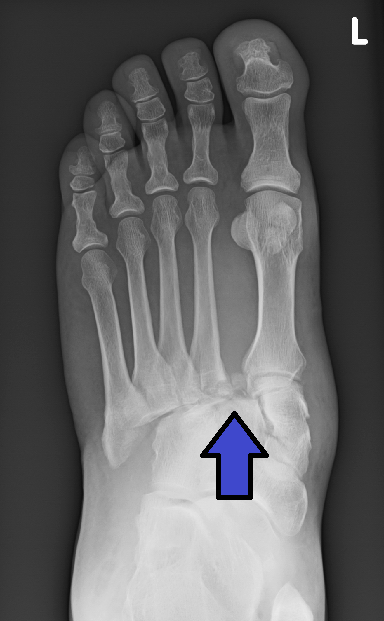A Lisfranc injury is a type of foot injury that involves damage to the ligaments and/or bones in the midfoot region, specifically the tarsometatarsal joint complex. This type of injury can range from mild to severe and often occurs due to traumatic events such as a direct impact, a fall, or a sudden twisting motion. Treatment for a Lisfranc injury depends on the severity of the injury and may involve both non-surgical and surgical approaches.
- Non-Surgical Treatment: For mild Lisfranc injuries or cases where the bones and ligaments are not significantly displaced, non-surgical treatment options may be considered. These options include:
- Rest and Immobilization: Immobilizing the foot with a cast, brace, or boot to allow the injured area to heal.
- Elevation: Keeping the foot elevated to minimize swelling and promote healing.
- Ice: Applying ice packs to the injured area to reduce swelling and pain.
- Anti-inflammatory Medications: Nonsteroidal anti-inflammatory drugs (NSAIDs) may be prescribed to help manage pain and inflammation.
- Physical Therapy: Once the acute phase has passed, physical therapy exercises can help regain strength, flexibility, and mobility in the foot.
- Surgical Treatment: Severe Lisfranc injuries, such as fractures and dislocations, often require surgical intervention to realign and stabilize the affected bones and joints. Surgical options include:
- Open Reduction and Internal Fixation (ORIF): This involves making an incision and using screws, plates, or other hardware to stabilize the bones and promote proper healing.
- Ligament Repair: If the ligaments are torn, they may need to be repaired or reconstructed to restore stability to the midfoot.
- Fusion: In some cases, fusion of the affected joints may be necessary to provide long-term stability. This involves joining the bones together using screws, plates, or other devices.
Recovery from a Lisfranc injury can take several months, and the treatment approach will depend on the individual’s overall health, the severity of the injury, and their activity level. Following the prescribed treatment plan, including any rehabilitation exercises, is essential for achieving the best possible outcome.
It’s important to note that I am not a medical professional, and you should always consult a qualified healthcare provider for accurate diagnosis and treatment recommendations tailored to your specific situation.


